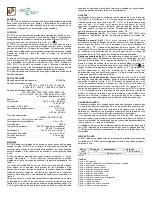
IntelliPack Series 801T Transmitter/Alarm User's Manual mV/TC/RTD Input
___________________________________________________________________________________________
- 5 -
Your application may differ from the default configuration and
will require that the transmitter be reconfigured to suit your needs.
This is accomplished with Acromag’s user-friendly Windows 95
or NT
Configuration Program and Serial Port Adapter.
Configuration is normally done prior to field installation since field
configurability via the module’s push-buttons is generally limited
to zero, full-scale, setpoint, and dropout adjustments. See the
Transmitter Configuration Manual (8500-570) for instructions.
Jumper Installation (For Voltage Output Only)
For voltage output, a short jumper must be installed between
the outp
ut “I+” and “JMP” terminals. A jumper wire has been
included with the unit and is already installed between the “JMP”
and I+ terminals. Verify jumper installation if your application
requires output voltage. Remove this jumper for current output
applications. Refer to the Electrical Connections Drawing
4501-681.
Mounting:
Refer to Enclosure Dimensions Drawing 4501-642 for
mounting and clearance dimensions.
DIN Rail Mounting:
This module can be mounted on "T"
type DIN rails. Use suitable fastening hardware to secure the
DIN rail to the mounting surface. Units may be mounted
side-by-side on 1-inch centers for limited space applications.
"T" Rail (35mm), Type EN50022:
To attach a module to this
style of DIN rail, angle the top of the unit towards the rail and
locate the top groove of the adapter over the upper lip of the
rail. Firmly push the unit towards the rail until it snaps solidly
into place. To remove a module, first separate the input
terminal block(s) from the bottom side of the module to
create a clearance to the DIN mounting area. Next, insert a
screwdriver into the lower arm of the DIN rail connector and
use it as a lever to force the connector down until the unit
disengages from the rail.
Electrical Connections
Output, power, and relay terminals can accommodate wire
from 12-24 AWG, stranded or solid copper. Strip back wire
insulation 1/4-inch on each lead before installing into the terminal
block. Input wiring should be shielded twisted-pair. Since
common mode voltages can exist on signal wiring, adequate wire
insulation should be used and proper wiring practices followed. It
is recommended that transmitter output and power wiring be
separated from the input signal wiring for safety, as well as for
low noise pickup. Note that input, power, output, and relay
terminal blocks are a plug-in type and can be easily removed to
facilitate module removal or replacement without removing
individual wires. If your application requires voltage output, you
must install a jumper between the out
put “I+” and “JMP”
terminals. This jumper is installed at the factory and should be
removed for current output applications. Be sure to remove
power and/or disable the load before unplugging the terminals to
uninstall the module, installing or removing jumpers, or before
attempting service. All connections must be made with power
removed.
CAUTION:
Risk of Electric Shock - More than one
disconnect switch may be required to de-energize the
equipment before servicing.
1.
Power:
Refer to Electrical Connections Drawing 4501-681.
Variations in power supply voltage within rated limits has
negligible effect on module accuracy. For supply
connections, use No. 14 AWG wires rated for at least 75
C.
The power terminal is diode-coupled for reverse polarity
protection.
2.
Input:
Connect input per Electrical Connections Drawing
4501-681. Observe proper polarity when making connections
(see label for input type).
3.
Analog Output Connections
: Wire outputs as shown in
Electrical Connections Drawing 4501-681. For voltage
output, you must also install a jumper between the output “I+”
and “JMP” terminals (installed at the factory). Remove this
jumper for current output.
Note:
For sensitive applications, high frequency noise may
be reduced by placing a 0.1uF capacitor directly across the
load.
4.
Output Relay Contacts
: Wire relay contacts as shown in
Electrical Connections Drawing 4501-
681. See the “Alarm
Relay Specifications” for power capacity. If necessary, an
interposing relay can be used to switch higher currents as
shown in Interposing Relay Connection Drawing 4501-646.
Electromechanical Relay Contact Protection:
To
maximize relay life with inductive loads, external protection is
required. For DC inductive loads, place a diode across the
load (1N4006 or equivalent) with cathode to (+) and anode to
(-). For AC inductive loads, place a Metal Oxide Varistor
(MOV) across the load. See Relay Contact Protection
Drawing 4501-646 for details.
IMPORTANT:
Noise and/or jitter on the input signal has the
effect of reducing (narrowing) the instrument’s deadband and
may produce contact chatter. The long term effect of this will
reduce the life of mechanical relays. To reduce this
undesired effect, you should increase the effective deadband.
Note that the input averaging function of this transmitter may
also be used to reduce contact chatter.
5.
Grounding:
See Electrical Connections Drawing 4501-681.
The module housing is plastic and does not require an earth
ground connection. However, there are mounting positions
on the output terminals to connect a cable shield, plus earth
ground. These connections are isolated from the internal
circuit and are recommended to minimize noise and help
protect the unit from damaging I/O transients.
WARNING:
For compliance to applicable safety and
performance standards, the use of shielded cable is
recommended as shown in Drawing 4501-681. Further, the
application of earth ground must be in place as shown in
Drawing 4501-681. Failure to adhere to sound wiring and
grounding practices may compromise safety & performance.






































